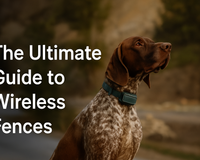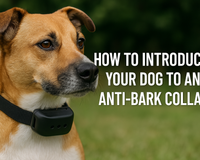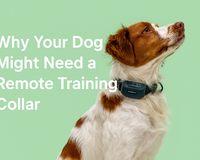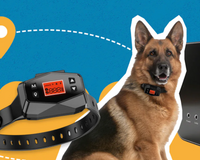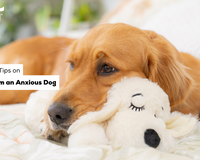Zoomies, jumping, spinning in circles while barking up a storm! This might sound like a happy and energetic dog, but it's not. These are signs of an overly-excited dog.
Your dog may have excess energy, and they have no idea how to deal with it, and it's worse than it sounds!
Since this behaviour is often confused with happiness, we unknowingly encourage it. We play with our pups and praise them for being excited. But if not addressed, overly excited dogs can lead to misbehaviours.
Below we explain what other signs an excited dog looks like and five easy tips to transform your excited dog into one that is happy and calm.
Why Does My Dog Get Overly Excited?
There are a few reasons why your dog turns into an overly excited dog.Energy and Exercise
How much exercise is your dog getting? Are you taking your dog out on daily walks or directing their energy elsewhere (like dog puzzles, playing fetch and running through an obstacle course)
These activities direct your dog's energy and stimulate their mind. It uses and drains their excess energy. It's easier to keep your dog calm when their energy is already directed at something!
Breed
Some dog breeds are known to be highly active and energetic. These breeds include Australian Shepherds, Dalmatians, Jack Russells, Siberian Huskies, Border Collies and Belgian Malinois'.
Specific Triggers
Take the time to watch your dog and see if anything specific triggers them. Does your dog try to chase everything on a walk? Do they bark or whine when excited? Are they frantic about seeing other animals or new humans entering the property?
Note the specific situations your dog gets overly excited with and what stimulus triggers this reaction. There is a difference between a dog that is happy to see you and a dog that sees you and runs around and jumps and barks.
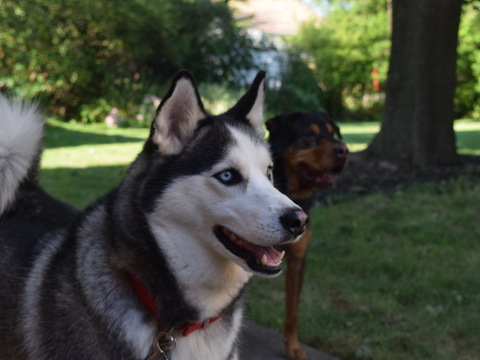
What Do Dogs Do When Over-Excited? What Does an Overly Excited Dog Look Like?
An excited dog is outwardly exuberant and energetic. Excitement varies; it depends on your dog and their personality. Some dogs might have a big wide grin with their tongue hanging out. Others may be vocalising non-stop, panting or jumping.
Excited dogs may also chatter their teeth, become mouthy and shake their body. They may also have dilated pupils and be excessively drooling. They may spin in circles, pace, or be unable to settle in one spot for any length of time.
An excited dog may freeze and fixate on a stimulus (like a toy or another dog). An excited dog will generally have a high heart rate and blood pressure.
5 Tips to Calm Your Overly Excited Dog
1. Exercise
An easy way to get all your dog's energy is to exercise them.
Having a consistent exercise routine lets your dog drain out their energy in a healthy way. Letting them run around the backyard isn't what we mean; that can leave your dog more excited afterwards as it isn't directing their energy on one thing.
Take walks, for example: when you go on walks, your dog's primal instincts will kick in. They stay focused on moving forward and staying with their pack. And once they're home, they feel satisfied with the reward; food, water and shelter.
2. Give Your Dog an Outlet
Another way to drain the excess energy out of your excited dog is to keep your dog's mind stimulated.
As mentioned before, playing fetch, searching for treats, enrichment toys or going through an obstacle course are great ways to channel their energy.
You can set the limitations. The game ends if the dog gets too excited.
Stopping the game is a gentle way to encourage the correct behaviour; it tells your dog that if they are too energetic, the fun goes away.
3. Encourage the Right Behaviours
When your excited dog approaches you, your reaction determines how often the over-excitement will appear again.
The worst way to respond to an excited dog is to give them affection and attention. Attention encourages their reaction, and they will associate excitement with a reward.
The best way to react to an excited dog is to ignore them, no touching, no eye contact and no talking. Turn the other way or push them back if your excited dog tries to jump on you.
Only give them affection, attention and treats when your dog is calm. Your dog will naturally move into a more relaxed state by rewarding calm and ignoring excited behaviour.
4. Use Their Nose
The primary organ of a dog is their nose, so capturing their sense of smell will keep them focused.
Lavender and vanilla are calming scents and incredibly powerful when associated with the dog in quiet times. Place a dog-friendly scented air freshener near your dogs' bed, and soon they will associate that smell with calm, relaxed times.
Make sure to check that your dog isn't allergic to any particular scents, and ask your veterinarian for their recommendations on calming dog scents.
5. Calm Yourself
Your excited dog will never calm down if you are over-excited too. So take note of your energy.
Can you stop unwanted behaviour with a quiet command, or do you have to yell? But if you shout at your dog, you also add to their excitement.
Think about it this: picture a pack of dogs in the wild. If they see an animal to prey on, they can't bark as that will scare it away. Instead, they communicate with their energy and body language.
It's your job to do the same. Communicate with your dog with your energy, encourage the right behaviours and discourage the wrong ones with your body language.
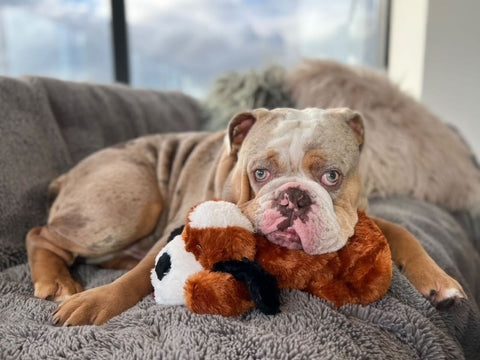
What Happens If You Never Train Your Excited Dog
If you let your excited dog continue to show this high energy behaviour, it could lead to redirected aggression.
Redirected Aggression
Redirected aggression is when a dog gets stimulated by a trigger (like a toy, human, or another animal), and something interferes. The energy it redirected from the trigger to the closest animal or human.
Redirected aggression is why people get bitten when they try to interfere in a dog fight. Another everyday example is two dogs at home, barking at a trigger they see through the fence. Sometimes in the heat of the moment, one will turn and attack the other.
It's worth noting that redirected aggression is found equally in both male and female dogs and amongst both puppies and adult dogs. If you're interested in learning about other types of dog aggression, check out our blog about understanding dog aggression.
Want to manage your dog's energy levels? Explore Dog Puzzles, Dog Interactive Toys, Fetch Toys and more.

